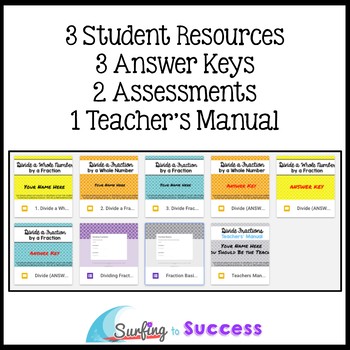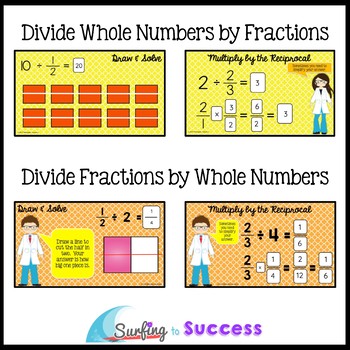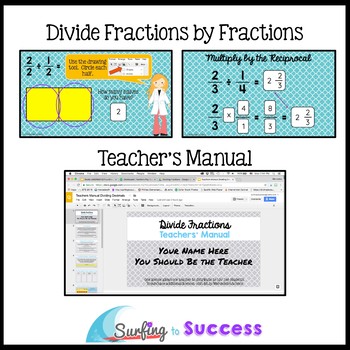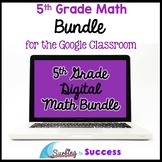Divide with Fractions: Interactive Math Google Classroom Distance Learning
Mercedes Hutchens
7.3k Followers
Grade Levels
5th - 6th
Subjects
Resource Type
Standards
CCSS5.NF.B.7
CCSS5.NF.B.7a
CCSS5.NF.B.7b
CCSS5.NF.B.7c
CCSS6.NS.A.1
Formats Included
- PDF
- Google Apps™
- Microsoft OneDrive
Pages
75 pages
Mercedes Hutchens
7.3k Followers

Includes Google Apps™
The Teacher-Author indicated this resource includes assets from Google Workspace (e.g. docs, slides, etc.).
What educators are saying
The perfect resource for introducing a new concept as well as aligned to CCSS. Excellent for extension/practice activities.
Great resource for use with students in distance learning. It helped unpack a very complicated math concept.
Also included in
- Digital interactive math resources for your Google Classroom. This bundle has math resources that fifth grade students can use with Google Slides. They can focus on one problem at a time. Digital resources can be so helpful because the color coding helps students focus on one part at a time.Price $43.20Original Price $48.00Save $4.80
Description
This 3 resource Dividing Fractions bundle contains Dividing Whole Numbers by Fractions, Dividing Fractions by Whole Numbers, and Dividing Fractions by Fractions.
Each skill starts with visual representations and then leads students to discover why the strategy of multiplying by the reciprocal is effective.
The download contains a link to the Teacher's Manual. The teachers manual includes links to 2 Google Quizzes. One quiz screens for prerequisite skills like multiplying fractions. The other can be used as a pre and/or post assessment.
Three digital Google Slides student resources are included. At the end of each slide deck there is an optional slide with links to online games and a YouTube video related to dividing with fractions. Those slides are great for early finishers.
Be sure to take a look at the preview to see two slides from each resource.
Instructions are included for use in Microsoft One Drive.
Be sure to check out my Google / Paperless category to see all my digital resources.
If you are just getting started using Google in your classroom you may find Introduction to Computer Basics for the Google Classroom helpful.
Do your students know their multiplication facts fluently? My Multiplication for the Google Classroom resource can help your students learn several strategies which will increase their fluency.
Each skill starts with visual representations and then leads students to discover why the strategy of multiplying by the reciprocal is effective.
The download contains a link to the Teacher's Manual. The teachers manual includes links to 2 Google Quizzes. One quiz screens for prerequisite skills like multiplying fractions. The other can be used as a pre and/or post assessment.
Three digital Google Slides student resources are included. At the end of each slide deck there is an optional slide with links to online games and a YouTube video related to dividing with fractions. Those slides are great for early finishers.
Be sure to take a look at the preview to see two slides from each resource.
Instructions are included for use in Microsoft One Drive.
Be sure to check out my Google / Paperless category to see all my digital resources.
If you are just getting started using Google in your classroom you may find Introduction to Computer Basics for the Google Classroom helpful.
Do your students know their multiplication facts fluently? My Multiplication for the Google Classroom resource can help your students learn several strategies which will increase their fluency.
Total Pages
75 pages
Answer Key
Included
Teaching Duration
2 Weeks
Report this resource to TPT
Reported resources will be reviewed by our team. Report this resource to let us know if this resource violates TPT’s content guidelines.
Standards
to see state-specific standards (only available in the US).
CCSS5.NF.B.7
Apply and extend previous understandings of division to divide unit fractions by whole numbers and whole numbers by unit fractions.
CCSS5.NF.B.7a
Interpret division of a unit fraction by a non-zero whole number, and compute such quotients. For example, create a story context for (1/3) ÷ 4, and use a visual fraction model to show the quotient. Use the relationship between multiplication and division to explain that (1/3) ÷ 4 = 1/12 because (1/12) × 4 = 1/3.
CCSS5.NF.B.7b
Interpret division of a whole number by a unit fraction, and compute such quotients. For example, create a story context for 4 ÷ (1/5), and use a visual fraction model to show the quotient. Use the relationship between multiplication and division to explain that 4 ÷ (1/5) = 20 because 20 × (1/5) = 4.
CCSS5.NF.B.7c
Solve real world problems involving division of unit fractions by non-zero whole numbers and division of whole numbers by unit fractions, e.g., by using visual fraction models and equations to represent the problem. For example, how much chocolate will each person get if 3 people share 1/2 lb of chocolate equally? How many 1/3-cup servings are in 2 cups of raisins?
CCSS6.NS.A.1
Interpret and compute quotients of fractions, and solve word problems involving division of fractions by fractions, e.g., by using visual fraction models and equations to represent the problem. For example, create a story context for (2/3) ÷ (3/4) and use a visual fraction model to show the quotient; use the relationship between multiplication and division to explain that (2/3) ÷ (3/4) = 8/9 because 3/4 of 8/9 is 2/3. (In general, (𝘢/𝘣) ÷ (𝘤/𝘥) = 𝘢𝘥/𝘣𝘤.) How much chocolate will each person get if 3 people share 1/2 lb of chocolate equally? How many 3/4-cup servings are in 2/3 of a cup of yogurt? How wide is a rectangular strip of land with length 3/4 mi and area 1/2 square mi?






